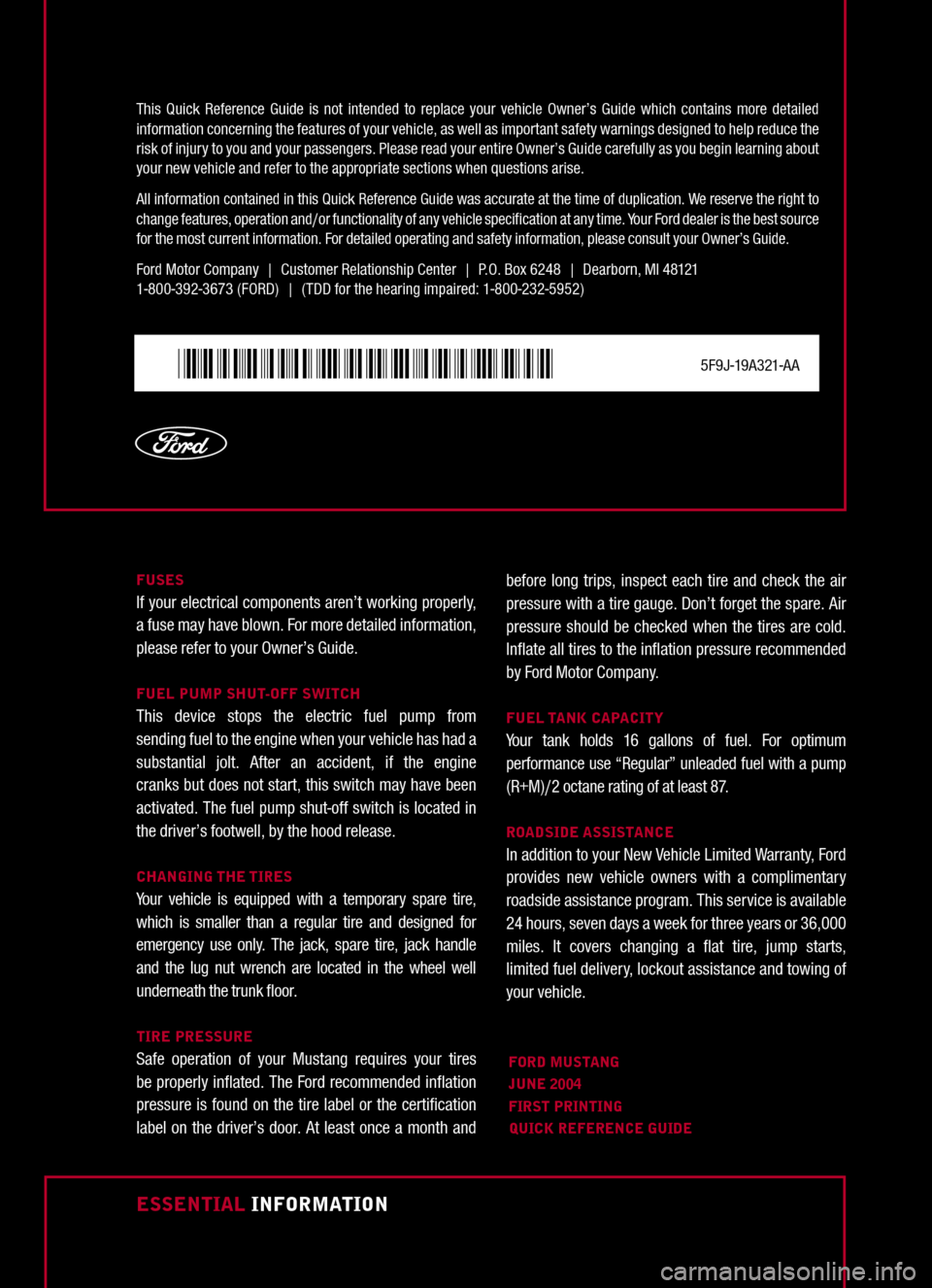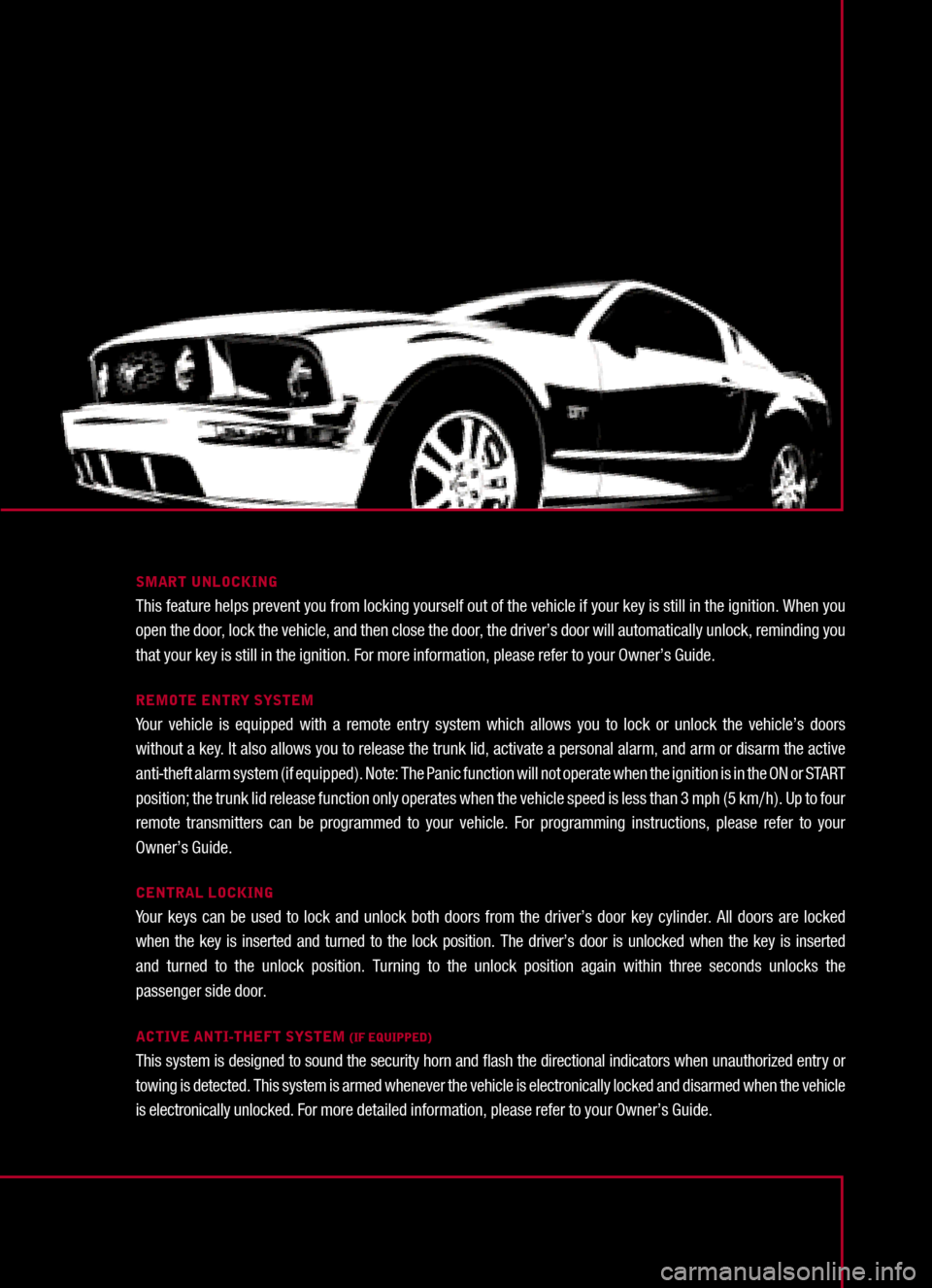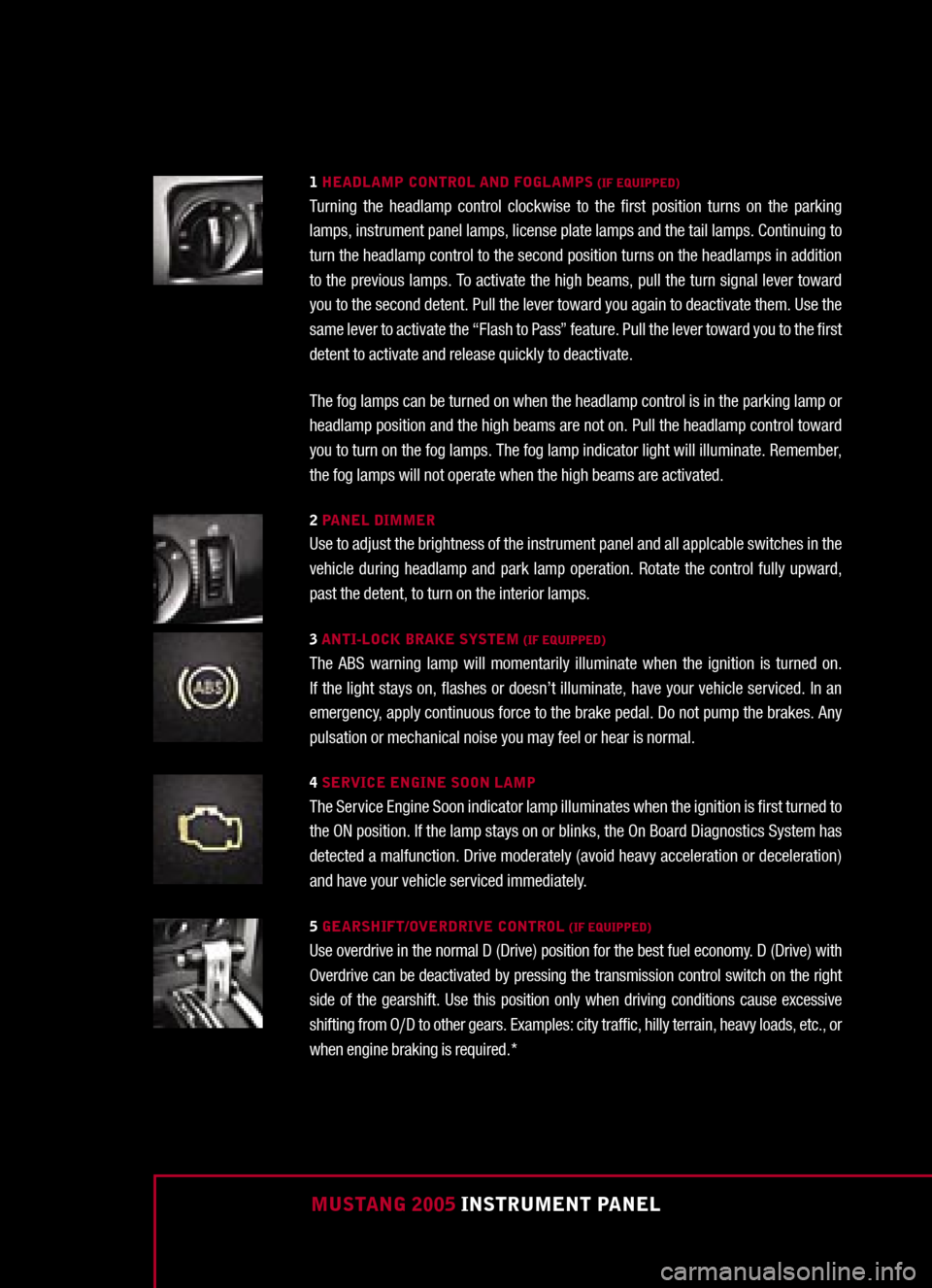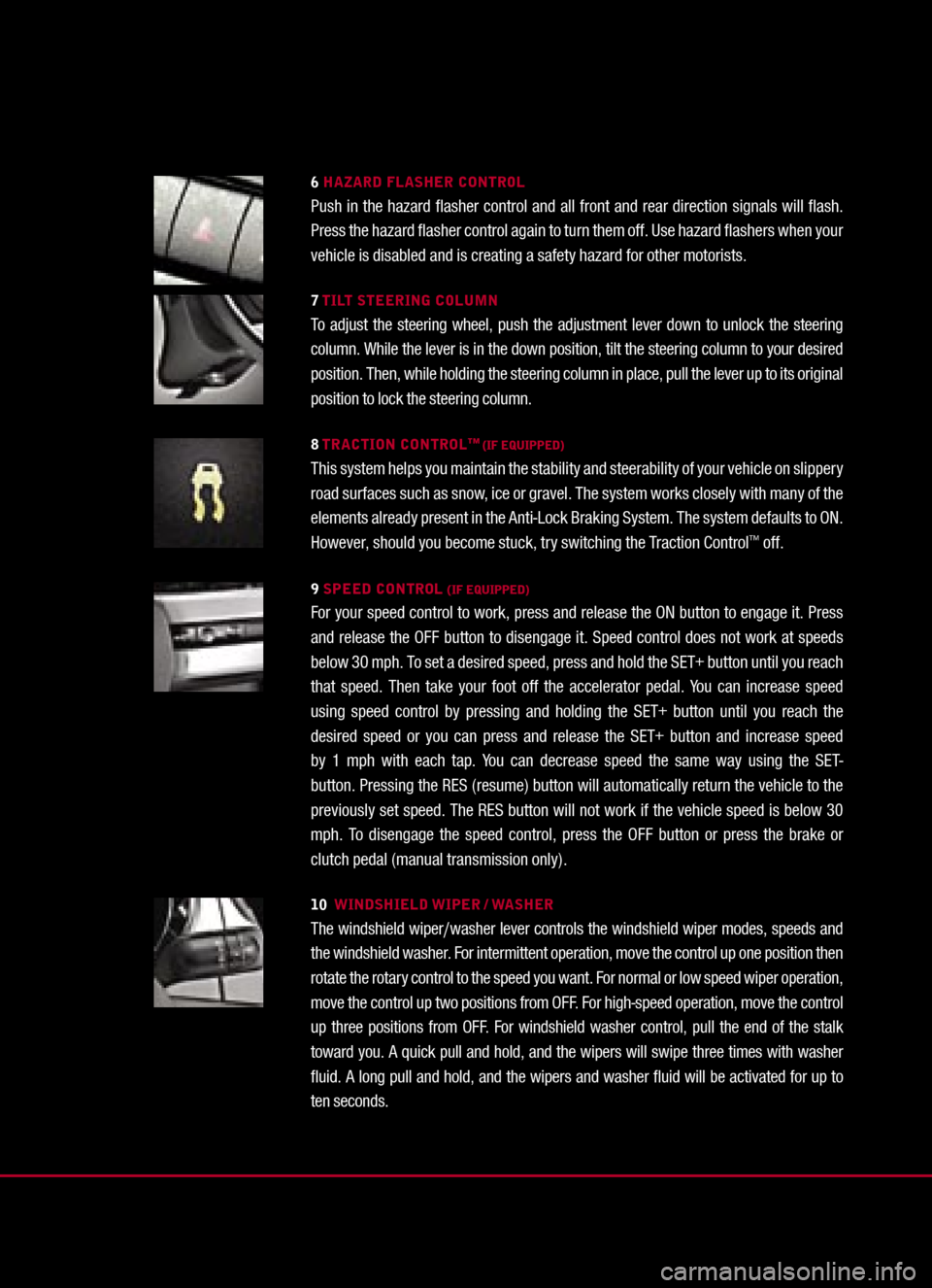tow FORD MUSTANG 2005 5.G Quick Reference Guide
[x] Cancel search | Manufacturer: FORD, Model Year: 2005, Model line: MUSTANG, Model: FORD MUSTANG 2005 5.GPages: 12, PDF Size: 0.26 MB
Page 1 of 12

FORD MUSTANGJUNE 2004FIRST PRINTINGQUICK REFERENCE GUIDE
яАаяАаяАкяБЖяА╡яБЖяА╣яБКяАняА▒яА╣яББяА│яА▓яА▒яАняББяББяАк5F9J-19A321-AA
ESSENTIAL INFORMATION
FUSESIf your electrical components arenтАЩt working properly, a fuse may have blown. For more detailed information, please refer to your OwnerтАЩs Guide.
FUEL PUMP SHUT-OFF SWITCHThis device stops the electric fuel pump from sending fuel to the engine when your vehicle has had a substantial jolt. After an accident, if the engine cranks but does not start, this switch may have been activated. The fuel pump shut-off switch is located in the driverтАЩs footwell, by the hood release.
CHANGING THE TIRESYour vehicle is equipped with a temporary spare tire, which is smaller than a regular tire and designed for emergency use only. The jack, spare tire, jack handle and the lug nut wrench are located in the wheel well underneath the trunk ямВoor.
TIRE PRESSURESafe operation of your Mustang requires your tires be properly inямВated. The Ford recommended inямВation pressure is found on the tire label or the certiямБcation label on the driverтАЩs door. At least once a month and
before long trips, inspect each tire and check the air pressure with a tire gauge. DonтАЩt forget the spare. Air pressure should be checked when the tires are cold. InямВate all tires to the inямВation pressure recommended by Ford Motor Company.
FUEL TANK CAPACITYYour tank holds 16 gallons of fuel. For optimum performance use тАЬRegularтАЭ unleaded fuel with a pump (R+M)/2 octane rating of at least 87.
ROADSIDE ASSISTANCEIn addition to your New Vehicle Limited Warranty, Ford provides new vehicle owners with a complimentary roadside assistance program. This service is available 24 hours, seven days a week for three years or 36,000 miles. It covers changing a ямВat tire, jump starts, limited fuel delivery, lockout assistance and towing of your vehicle.
This Quick Reference Guide is not intended to replace your vehicle OwnerтАЩs Guide which contains more detailed information concerning the features of your vehicle, as well as important safety warnings designed to help reduce the risk of injury to you and your passengers. Please read your entire OwnerтАЩs Guide carefully as you begin learning about your new vehicle and refer to the appropriate sections when questions arise.
All information contained in this Quick Reference Guide was accurate at the time of duplication. We reserve the right to change features, operation and/or functionality of any vehicle speciямБcation at any time. Your Ford dealer is the best source for the most current information. For detailed operating and safety information, please consult your OwnerтАЩs Guide.
Ford Motor Company | Customer Relationship Center | P.O. Box 6248 | Dearborn, MI 48121 1-800-392-3673 (FORD) | (TDD for the hearing impaired: 1-800-232-5952)
Page 4 of 12

MUSTANG QUICK REFERENCE GUIDE 2005
SMART UNLOCKINGThis feature helps prevent you from locking yourself out of the vehicle if your key is still in the ignition. When you open the door, lock the vehicle, and then close the door, the driverтАЩs door will automatically unlock, reminding you that your key is still in the ignition. For more information, please refer to your OwnerтАЩs Guide.
REMOTE ENTRY SYSTEMYour vehicle is equipped with a remote entry system which allows you to lock or unlock the vehicleтАЩs doors without a key. It also allows you to release the trunk lid, activate a personal alarm, and arm or disarm the active anti-theft alarm system (if equipped). Note: The Panic function will not operate when the ignition is in the ON or START position; the trunk lid release function only operates when the vehicle speed is less than 3 mph (5 km/h). Up to four remote transmitters can be programmed to your vehicle. For programming instructions, please refer to your OwnerтАЩs Guide.
CENTRAL LOCKINGYour keys can be used to lock and unlock both doors from the driverтАЩs door key cylinder. All doors are locked when the key is inserted and turned to the lock position. The driverтАЩs door is unlocked when the key is inserted and turned to the unlock position. Turning to the unlock position again within three seconds unlocks the passenger side door.
ACTIVE ANTI-THEFT SYSTEM (IF EQUIPPED)This system is designed to sound the security horn and ямВash the directional indicators when unauthorized entry or towing is detected. This system is armed whenever the vehicle is electronically locked and disarmed when the vehicle is electronically unlocked. For more detailed information, please refer to your OwnerтАЩs Guide.
Page 10 of 12

1 HEADLAMP CONTROL AND FOGLAMPS (IF EQUIPPED)Turning the headlamp control clockwise to the ямБrst position turns on the parking lamps, instrument panel lamps, license plate lamps and the tail lamps. Continuing to turn the headlamp control to the second position turns on the headlamps in addition to the previous lamps. To activate the high beams, pull the turn signal lever toward you to the second detent. Pull the lever toward you again to deactivate them. Use the same lever to activate the тАЬFlash to PassтАЭ feature. Pull the lever toward you to the ямБrst detent to activate and release quickly to deactivate.
The fog lamps can be turned on when the headlamp control is in the parking lamp or headlamp position and the high beams are not on. Pull the headlamp control toward you to turn on the fog lamps. The fog lamp indicator light will illuminate. Remember, the fog lamps will not operate when the high beams are activated.
2 PANEL DIMMERUse to adjust the brightness of the instrument panel and all applcable switches in the vehicle during headlamp and park lamp operation. Rotate the control fully upward, past the detent, to turn on the interior lamps.
3 ANTI-LOCK BRAKE SYSTEM (IF EQUIPPED)
The ABS warning lamp will momentarily illuminate when the ignition is turned on. If the light stays on, ямВashes or doesnтАЩt illuminate, have your vehicle serviced. In an emergency, apply continuous force to the brake pedal. Do not pump the brakes. Any pulsation or mechanical noise you may feel or hear is normal.
4 SERVICE ENGINE SOON LAMPThe Service Engine Soon indicator lamp illuminates when the ignition is ямБrst turned to the ON position. If the lamp stays on or blinks, the On Board Diagnostics System has detected a malfunction. Drive moderately (avoid heavy acceleration or deceleration) and have your vehicle serviced immediately.
5 GEARSHIFT/OVERDRIVE CONTROL (IF EQUIPPED)Use overdrive in the normal D (Drive) position for the best fuel economy. D (Drive) with Overdrive can be deactivated by pressing the transmission control switch on the right side of the gearshift. Use this position only when driving conditions cause excessive shifting from O/D to other gears. Examples: city trafямБc, hilly terrain, heavy loads, etc., or when engine braking is required.*
MUSTANG 2005 INSTRUMENT PANEL
Page 11 of 12

6 HAZARD FLASHER CONTROLPush in the hazard ямВasher control and all front and rear direction signals will ямВash. Press the hazard ямВasher control again to turn them off. Use hazard ямВashers when your vehicle is disabled and is creating a safety hazard for other motorists.
7 TILT STEERING COLUMNTo adjust the steering wheel, push the adjustment lever down to unlock the steering column. While the lever is in the down position, tilt the steering column to your desired position. Then, while holding the steering column in place, pull the lever up to its original position to lock the steering column.
8 TRACTION CONTROLтДв (IF EQUIPPED)This system helps you maintain the stability and steerability of your vehicle on slippery road surfaces such as snow, ice or gravel. The system works closely with many of the elements already present in the Anti-Lock Braking System. The system defaults to ON. However, should you become stuck, try switching the Traction ControlтДв off.
9 SPEED CONTROL (IF EQUIPPED)For your speed control to work, press and release the ON button to engage it. Press and release the OFF button to disengage it. Speed control does not work at speeds
below 30 mph. To set a desired speed, press and hold the SET+ button until you reach that speed. Then take your foot off the accelerator pedal. You can increase speed using speed control by pressing and holding the SET+ button until you reach the desired speed or you can press and release the SET+ button and increase speed by 1 mph with each tap. You can decrease speed the same way using the SET- button. Pressing the RES (resume) button will automatically return the vehicle to the previously set speed. The RES button will not work if the vehicle speed is below 30 mph. To disengage the speed control, press the OFF button or press the brake or clutch pedal (manual transmission only).
10 WINDSHIELD WIPER / WASHERThe windshield wiper/washer lever controls the windshield wiper modes, speeds and the windshield washer. For intermittent operation, move the control up one position then rotate the rotary control to the speed you want. For normal or low speed wiper operation, move the control up two positions from OFF. For high-speed operation, move the control up three positions from OFF. For windshield washer control, pull the end of the stalk toward you. A quick pull and hold, and the wipers will swipe three times with washer ямВuid. A long pull and hold, and the wipers and washer ямВuid will be activated for up to ten seconds.